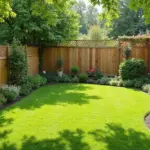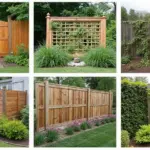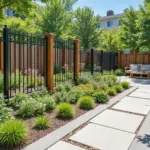Finding the perfect steps for your above ground pool can transform your backyard oasis from ordinary to extraordinary. We’ve all been there – struggling with flimsy ladder steps that wobble with every climb or dealing with uncomfortable entry points that make pool time less enjoyable than it should be.
The right pool steps don’t just provide safe access – they enhance your pool’s aesthetic appeal and boost your property value. Whether you’re working with a tight budget or ready to invest in premium features we’ll explore creative answers that match every style and need.
From elegant stone-inspired designs to space-saving multi-functional steps with built-in storage our comprehensive guide covers innovative ideas that’ll make your neighbors envious. We’ll show you how to choose steps that complement your pool’s design while prioritizing safety and durability for years of worry-free swimming.
Safety First: Essential Features Every Above Ground Pool Step Should Have
Building on our discussion of style and design options, we must prioritize safety features that protect swimmers and prevent accidents. These essential elements form the foundation of any reliable above ground pool step system.
Non-Slip Surface Materials
Textured surfaces provide the most reliable grip when wet, preventing dangerous slips during pool entry and exit. We recommend steps with diamond plate patterns, rubberized coatings, or molded grip ridges that maintain traction even when covered in water or pool chemicals.
Commercial-grade materials like marine-grade aluminum with anti-slip treatments offer superior durability compared to smooth plastic surfaces. These materials resist algae buildup and maintain their grip properties through multiple seasons of use.
Drainage channels integrated into step surfaces prevent water pooling that creates hazardous conditions. Look for steps with built-in grooves or perforated designs that allow water to flow through rather than accumulate on walking surfaces.
Sturdy Handrail Requirements
Dual handrails on both sides of pool steps provide maximum stability for users of all ages and mobility levels. We’ve found that steps with handrails positioned 32 to 36 inches high offer optimal support for most adults while remaining accessible for children.
Corrosion-resistant construction ensures handrails maintain their strength over time when exposed to pool chemicals and weather conditions. Powder-coated steel, marine-grade aluminum, or high-quality stainless steel options resist rust and structural degradation.
Secure mounting systems with through-bolts or heavy-duty brackets prevent handrail wobbling that compromises user confidence. Quality installations feature multiple attachment points that distribute weight evenly across the step structure.
Weight Capacity Considerations
Minimum load ratings of 300 pounds per step ensure safe usage for most adults, though we recommend choosing steps rated for 400 to 500 pounds for enhanced durability. Higher capacity ratings also accommodate multiple users and reduce structural stress during normal operation.
Ever-changing load testing certifications from manufacturers indicate steps can handle movement and shifting weight typical during pool entry. Static weight limits don’t account for the additional forces created when users climb or descend steps.
Professional installation requirements often specify weight distribution calculations to ensure proper support foundation. We always verify that decking or ground surfaces can handle the combined weight of the step system plus maximum user capacity.
| Safety Feature | Minimum Standard | Recommended Upgrade |
|---|---|---|
| Weight Capacity | 300 lbs per step | 400-500 lbs per step |
| Handrail Height | 32 inches | 34-36 inches |
| Non-Slip Rating | Commercial grade | Marine grade |
| Mounting Points | 4 per handrail | 6-8 per handrail |
Budget-Friendly DIY Above Ground Pool Steps Ideas

Now that we’ve covered safety features, let’s explore cost-effective DIY answers that won’t expensive while delivering both functionality and style.
Wooden Deck Step Construction
Building wooden steps creates a sturdy and attractive entrance to your above ground pool. We recommend designing a three-step staircase approximately 40 inches wide for comfortable access and easy navigation.
Start with 4×4 posts and 4×6 lumber to construct a robust frame that can handle regular use. Bolt the frame components securely together and reinforce with additional support posts for maximum stability. Attach this framework firmly to your pool’s edge using appropriate hardware.
Add stair treads with textured surfaces to prevent slipping when wet. Sand all edges thoroughly to eliminate splinters that could cause injury. Consider installing handrails on both sides for added safety and support.
This method allows complete customization to match your pool’s height and your backyard’s aesthetic. You’ll need basic tools like a drill, saw, and measuring tape, plus affordable lumber and standard hardware from any home improvement store.
Concrete Block Step Design
Concrete blocks offer an incredibly budget-friendly solution that requires minimal carpentry skills. Stack cinder blocks to form your desired step configuration, creating a solid foundation that won’t shift over time.
Place 4×6 lumber planks on top of the blocks to create comfortable treads. Secure the wood planks to the concrete blocks using appropriate fasteners to ensure stability during use. This combination provides durability while maintaining affordability.
The assembly process takes just a few hours and doesn’t require extensive building experience. Concrete blocks naturally resist weather damage, making this option suitable for both temporary and permanent installations.
Videos demonstrate how simple this construction method really is, showing step-by-step assembly that most homeowners can complete in an afternoon.
Repurposed Ladder Answers
Transforming an old ladder into pool steps represents the ultimate in creative recycling and cost savings. Use either wooden or metal ladders as your foundation, depending on what’s available in your garage or local secondhand market.
Modify the existing ladder by adding wider treads or attaching decking boards for more comfortable footing. Paint or apply protective coatings to extend the ladder’s life and improve weather resistance.
Secure the repurposed ladder safely against your pool structure to prevent any movement during use. Add anti-slip materials to each step surface for enhanced safety.
This solution combines minimal expense with decent functionality, though we emphasize the importance of reinforcing and properly stabilizing the ladder before use. Check all joints and connections regularly to maintain safety standards.
Premium Ready-Made Above Ground Pool Step Options
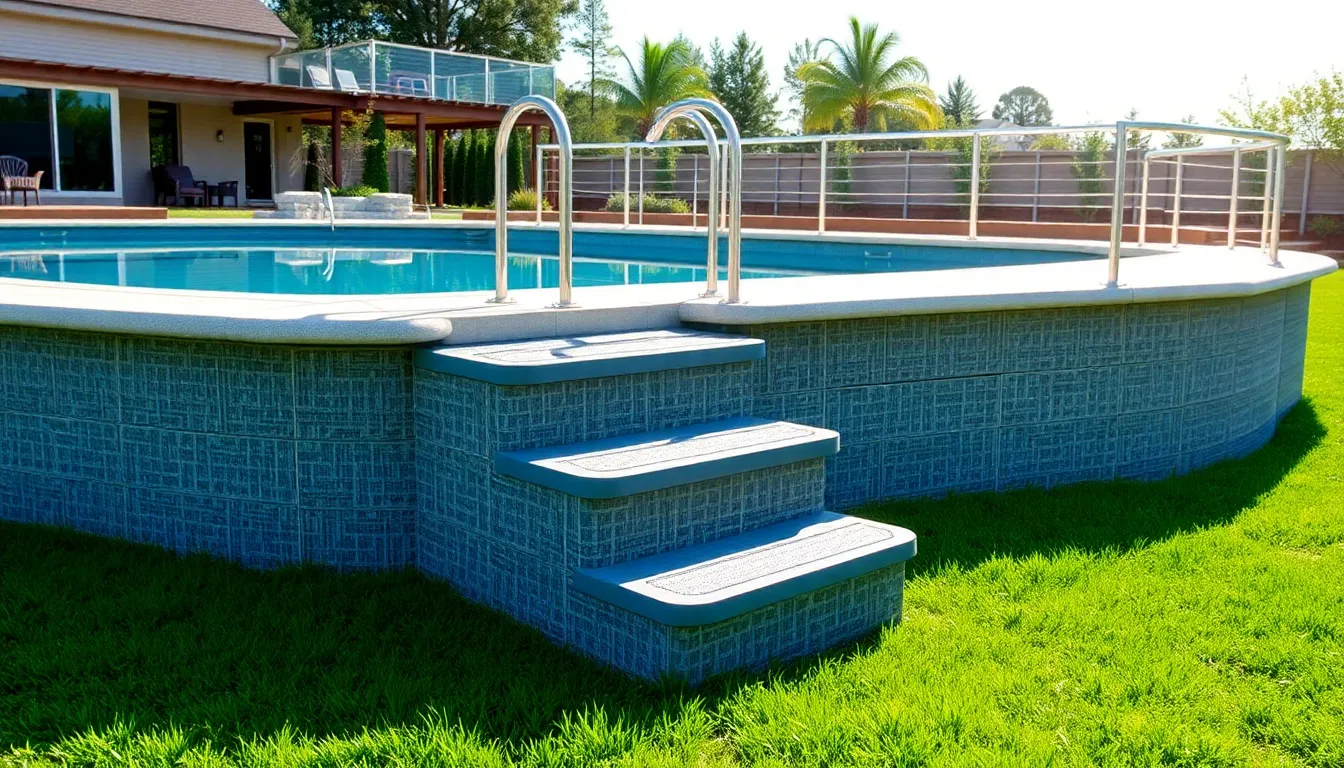
Moving beyond DIY answers, we’ll explore premium ready-made options that offer professional quality and hassle-free installation. These manufactured step systems provide superior durability and safety features that can transform your pool access experience.
Heavy-Duty Resin Step Systems
Heavy-duty resin steps represent one of our top recommendations for above ground pool access. These systems resist rust, corrosion, and UV damage while maintaining their appearance year after year. Wide steps provide exceptional comfort and stability, making entry and exit safer for users of all ages.
Multiple level platforms are common in resin step designs, offering versatile configurations that adapt to different pool heights. Lightweight construction makes these steps easy to move when needed, yet they’re engineered to support both adults and children safely. Molded construction requires minimal maintenance compared to traditional materials, saving you time and effort.
Freestanding models offer flexibility in placement, while attachable versions connect directly to your pool side or existing deck structure. Non-slip treads come standard on most premium resin systems, providing secure footing even when wet. Weather-resistant materials ensure these steps withstand outdoor conditions without deteriorating or fading.
Stainless Steel Entry Steps
Stainless steel steps deliver unmatched durability and sophisticated aesthetics for discerning pool owners. These premium systems feature rust-resistant frames that perform exceptionally well in humid or coastal environments where corrosion typically becomes a concern. Sleek designs complement modern pool installations while providing long-lasting functionality.
Combined construction using stainless steel frames with plastic or resin step treads offers the perfect balance of strength and comfort. Higher initial costs reflect the superior materials and manufacturing quality, making these steps a worthwhile investment for permanent installations. Fixed or bolted mounting systems ensure maximum stability during use.
Handrails are frequently paired with stainless steel steps, providing additional safety and support for users entering and exiting the pool. Professional appearance enhances your backyard’s overall aesthetic appeal while maintaining practical functionality. Corrosion resistance makes these steps ideal for pools in challenging weather conditions.
Multi-Level Deck Integration
Integrating pool steps into multi-level deck systems creates the most sophisticated and functional pool access solution available. Deck stairs leading to your above ground pool provide seamless transitions that enhance your entire poolside experience. Custom design possibilities allow you to match your existing outdoor living space perfectly.
Wide platforms incorporated into deck designs offer generous space for relaxation and pool activities. Handrails become architectural elements that provide safety while complementing your deck’s style and materials. Construction options include wood, composite, or PVC materials that coordinate with your deck’s existing finish.
DIY plans and professional installation guides are readily available for homeowners who want custom deck stairs customized to exact pool heights. Detailed material lists help you budget accurately for these comprehensive projects. Harmonious integration creates spacious pool areas that significantly increase your property’s functional outdoor living space.
Professional design services can help you plan multi-level systems that accommodate various pool sizes and backyard layouts. Enhanced usability makes your pool area more inviting for entertaining and family activities. Custom answers provide the ultimate combination of functionality and aesthetic appeal for serious pool enthusiasts.
Creative Design Ideas for Above Ground Pool Steps
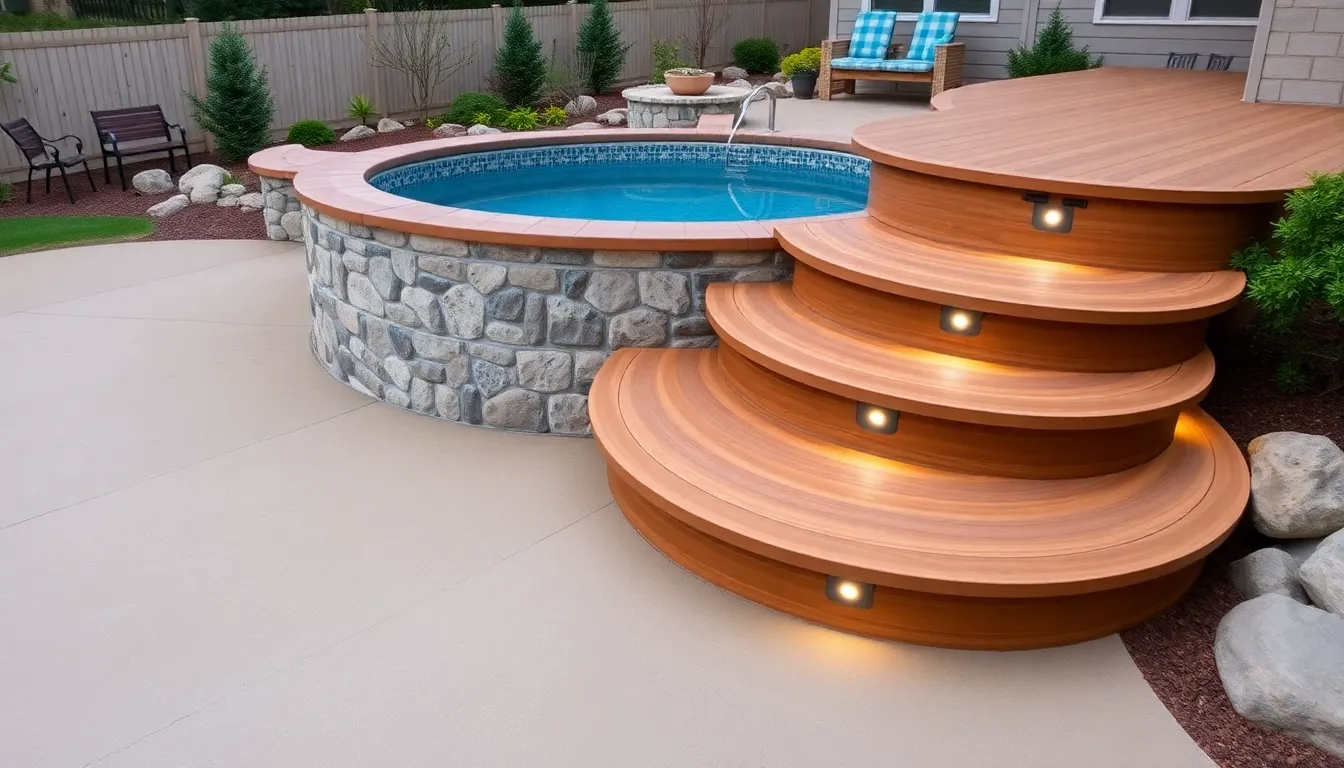
Now that we’ve covered safety essentials and explored various construction options, let’s jump into innovative design concepts that’ll transform your pool steps from purely functional to truly spectacular.
Curved and Spiral Step Designs
Curved steps create an elegant, flowing transition that transforms your above ground pool into a backyard centerpiece. We’ve seen how these graceful designs break away from traditional straight lines, offering a sophisticated aesthetic that complements modern pool installations. Spiral configurations maximize space efficiency while creating a stunning visual focal point that draws the eye upward.
Wide, lounge style curved steps serve multiple purposes beyond simple pool entry. They become social platforms perfect for sunbathing or supervising children during swim time. Materials like composite decking, natural wood, or porcelain tiles can create these flowing designs to match your backyard’s existing style.
Space conscious homeowners particularly benefit from spiral step designs in smaller backyard setups. These configurations require less deck space while providing the same functionality as traditional straight steps.
Integrated Storage Answers
Storage integrated steps eliminate pool deck clutter while keeping essentials within arm’s reach. We recommend incorporating built in compartments or drawers directly into your step construction for maximum efficiency. Pool toys, cleaning tools, and towels can disappear from view while remaining easily accessible.
Custom wooden and composite step designs often feature these integrated storage answers customized to your exact pool size and location. Hidden compartments maintain the clean aesthetic of your pool area while providing practical organization for all your swimming accessories.
Drawer style storage works particularly well in wider step designs where deeper compartments can accommodate larger items like pool noodles and maintenance equipment.
LED Lighting Integration
LED lighting transforms your pool steps into a sophisticated nighttime feature while dramatically improving safety. We’ve found that LED strips hidden under each tread provide subtle illumination without cluttering the overall design aesthetic. Handrail integrated lighting offers additional safety guidance during evening swimming sessions.
Color customization options allow you to match your pool’s ambiance and create different moods for various occasions. Matte finish porcelain tiles combined with hidden LED strips deliver a sleek, minimalist appearance that supports safe evening pool use.
Modern LED technology consumes minimal energy while delivering maximum visual impact, making these lighting answers both practical and environmentally conscious. The combination of safety enhancement and aesthetic appeal makes LED integration a worthwhile investment for serious pool enthusiasts.
Pool Deck Integration Step Concepts
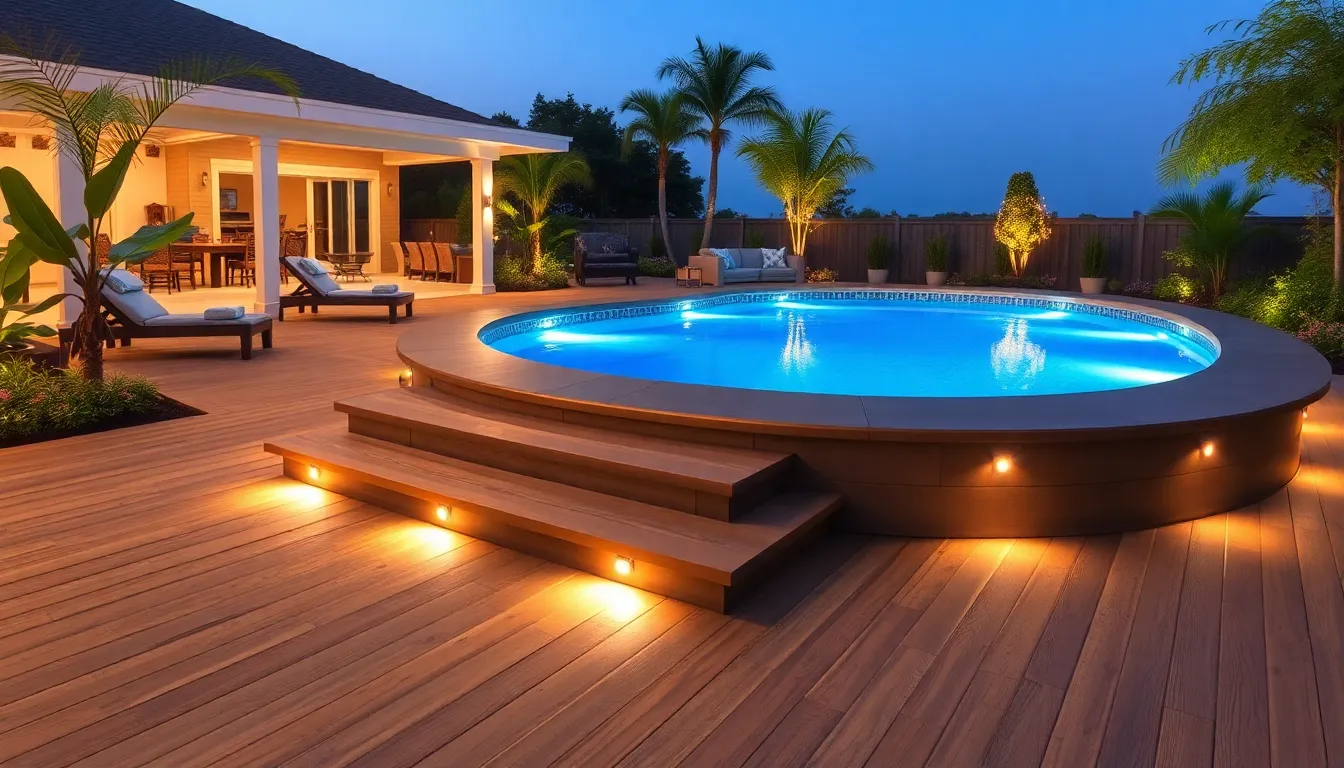
Integrating pool steps directly into your deck design creates a seamless transition that transforms your above ground pool into a sophisticated outdoor living space. These integrated answers offer both practical access and enhanced aesthetic appeal.
Wraparound Deck with Built-In Steps
Building wraparound decks around your pool allows you to incorporate built-in steps that serve dual purposes as entry points and comfortable seating areas. This design creates seamless access while expanding your outdoor entertainment space significantly.
Wide, lounge-style entry steps running along one side of the pool provide ample space for sunbathing and create family-friendly access points that children can use safely. These generous steps can be surfaced with oversized porcelain tiles in neutral tones to match your existing deck materials.
Installing integrated handrails or grab bars enhances stability during pool entry and exit. Durable materials that blend with your decking ensure a cohesive appearance while providing the safety features you need.
Using broad treads in your step design improves water drainage and reduces slip hazards around the pool area. This practical feature becomes especially important during peak swimming season when wet surfaces pose safety concerns.
Floating Deck Entry Points
Creating floating deck platforms adjacent to your above ground pool offers a modern, minimalist approach to pool access. These independent or connected structures appear to “float” beside your pool while providing clean, sophisticated entry points.
Constructing floating decks from wood or composite materials gives you flexibility in customization and styling options. These platforms can accommodate various pool heights and backyard layouts while maintaining their distinctive appearance.
Adding LED lighting to floating deck steps enhances both safety and visual appeal during evening pool use. Minimalist railings provide necessary safety features without compromising the clean, contemporary aesthetic.
Positioning floating decks strategically allows you to create multiple access points around your pool perimeter. This flexibility proves especially valuable for larger gatherings or when accommodating different user preferences.
Multi-Tier Deck Systems
Designing multi-tier deck systems combines several levels of decking with connecting steps to create ever-changing, layered poolside environments. These systems allow you to establish distinct areas for lounging, dining, and pool access within a cohesive design framework.
Wide steps connecting each tier provide social seating opportunities while ensuring safe transitions between levels. Materials like wood, composite decking, or porcelain tiles can be mixed and matched to create visual interest and define different functional zones.
Integrating landscaping or garden features within your multi-tier system enhances the overall backyard aesthetic. These natural elements soften the hard edges of decking materials while creating a more resort-like atmosphere.
Planning your multi-tier system with varying step heights accommodates different activities and user needs. Lower steps work well for casual seating, while standard-height steps provide efficient pool access for swimmers.
Space-Saving Above Ground Pool Step Solutions
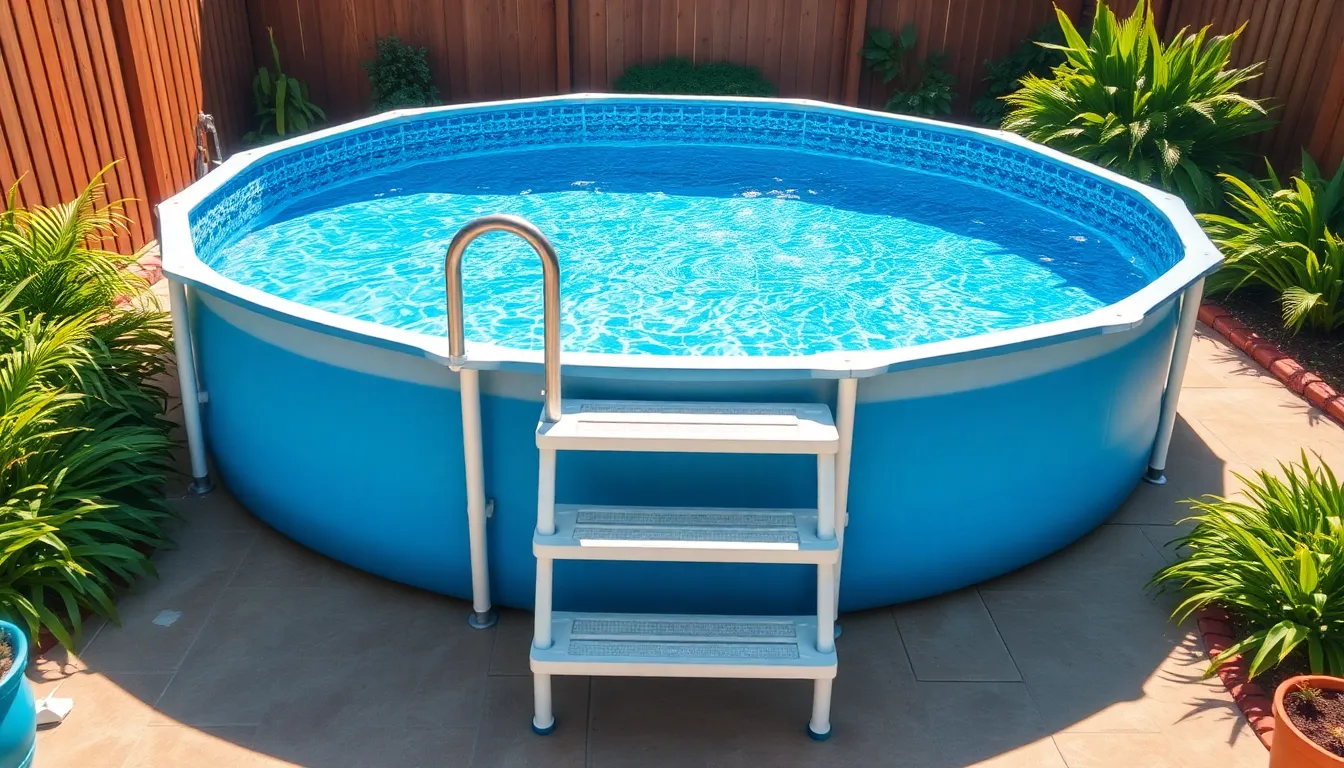
When yard space is at a premium, choosing the right step design can make all the difference in your pool area’s functionality and appearance.
Compact Folding Step Designs
Folding steps revolutionize pool access by collapsing when not in use, freeing up valuable deck space for entertaining or relaxation. We’ve found these innovative designs particularly beneficial for smaller backyards where every square foot matters. Weather-resistant plastic and treated wood construction ensures these steps withstand outdoor conditions while maintaining their folding functionality.
Storage becomes effortless during winter months since folding designs can be completely collapsed or disassembled. This prevents damage from freezing temperatures and ice formation that commonly affects permanently installed steps. Many homeowners appreciate how these steps eliminate the permanent footprint around their pool, creating a cleaner, more versatile outdoor space.
Removable Step Options
Detachable steps offer ultimate flexibility by allowing complete removal when hosting poolside activities or during off-season storage. We recommend these lightweight answers for their secure mounting brackets or hooks that attach directly to pool frames or existing decks. Quick installation and removal make these steps ideal for families who want to restrict pool access during exact times.
Protection from harsh weather extends the lifespan of removable steps significantly compared to permanent installations. Debris accumulation becomes less of an issue since steps can be stored in garages or sheds during storms or winter months. Enhanced safety features make these steps particularly appealing to parents who need to control pool access for young children.
Corner-Mounted Entry Systems
Strategic corner placement maximizes usable pool space by utilizing areas that typically go unused around above ground pools. We’ve observed how these systems free up prime deck real estate while providing wider steps and integrated handrails for safer access. Wood or composite decking materials allow seamless integration with existing pool deck systems for a cohesive aesthetic.
Multiple access points become possible with corner-mounted designs, particularly beneficial for larger above ground pools that serve multiple users. Built-in handrails and wider step platforms accommodate users of different ages and mobility levels more effectively than traditional center-mounted options. These systems often integrate with larger deck projects, creating a professional, custom appearance that enhances property value.
Maintenance and Durability Considerations
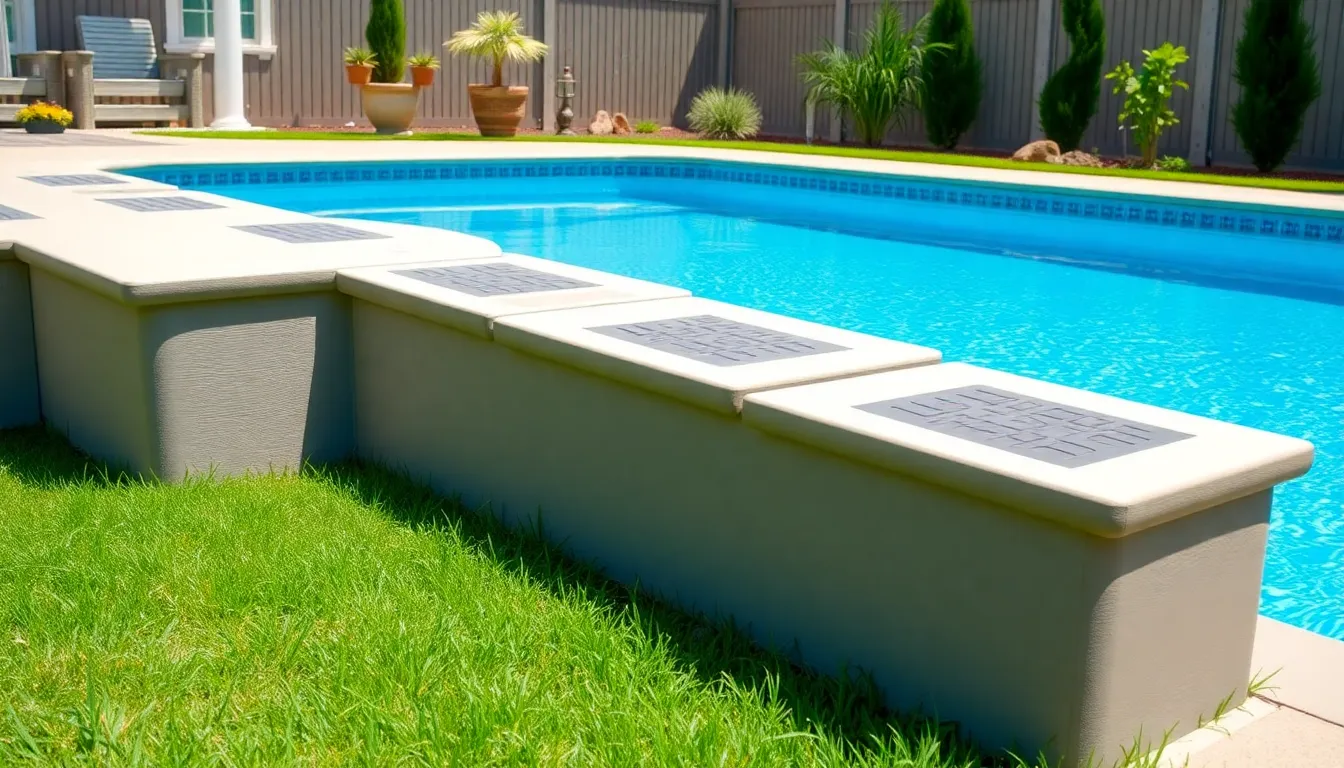
Selecting pool steps that stand the test of time requires careful attention to materials and construction methods. We’ll explore how proper material choices and maintenance practices ensure your investment remains safe and functional for years to come.
Weather-Resistant Material Choices
Treated wood offers excellent durability when properly sealed and maintained through regular resealing schedules. Composite decking materials provide superior resistance to moisture and UV rays while requiring minimal maintenance compared to traditional wood options. Molded plastic and resin steps eliminate corrosion concerns entirely and offer lightweight construction that’s easy to clean and reposition.
Pool chemicals create harsh conditions that quickly deteriorate inferior materials. We recommend composite materials specifically designed for pool environments since they resist staining and maintain their appearance even though constant chemical exposure. Plastic steps manufactured from high-density materials won’t crack or fade under intense sun exposure.
Weather resistance becomes critical during seasonal changes and extreme conditions. Materials must withstand temperature fluctuations without warping or becoming brittle during winter months.
Easy-Clean Step Surfaces
Smooth surfaces without deep grooves prevent algae buildup and simplify weekly cleaning routines. Non-slip textures integrated into step treads provide safety without creating difficult-to-clean crevices where debris accumulates. Removable step components allow thorough cleaning underneath and around support structures.
Composite materials rinse clean with standard pool brushes and don’t require specialized cleaning products. We’ve found that surfaces designed specifically for pool use resist chemical staining better than general outdoor materials. Modular step designs let you remove individual components for deep cleaning when necessary.
Step surfaces should drain quickly to prevent standing water that promotes bacterial growth. Drainage channels built into the step design eliminate water pooling while maintaining smooth walking surfaces.
Long-Term Structural Integrity
Strong framing using treated lumber such as 4×4 posts and 4×6 beams creates the foundation for lasting stability. Carriage bolts and deck screws provide secure assembly that won’t loosen over time from pool vibrations and regular use. Supporting posts placed under taller step configurations prevent sagging that compromises safety.
Proper attachment to the pool edge prevents shifting during entry and exit activities. We recommend securing the frame directly to pool walls using appropriate fasteners designed for your exact pool material. Handrails add structural support while improving user safety during wet conditions.
Weight distribution across multiple support points ensures steps remain stable even when multiple people use them simultaneously. Steps rated for 400 to 500 pounds accommodate typical family use while providing safety margins for unexpected loads.
Regular inspections help identify loose fittings before they become safety hazards. Prompt repairs of minor damage prevent structural issues from spreading and requiring complete step replacement.
Installation Tips for Above Ground Pool Steps
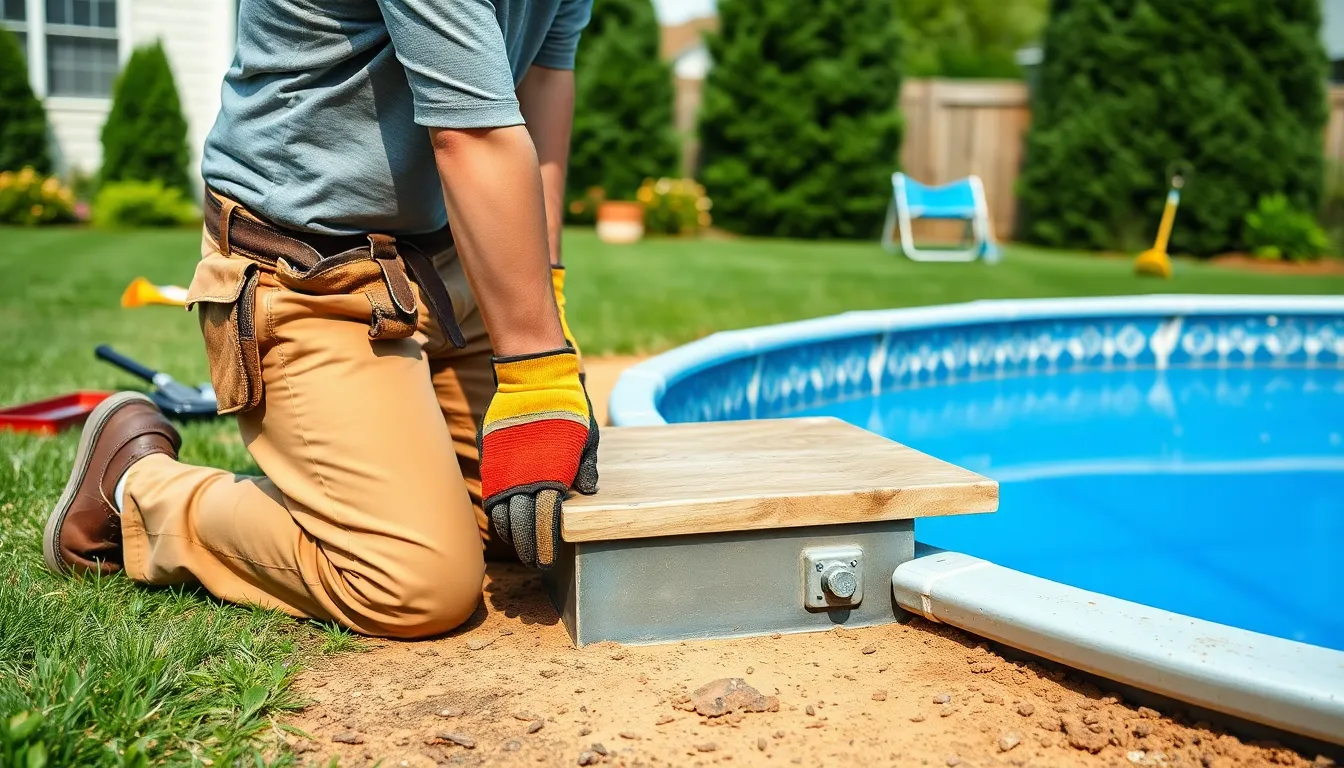
Proper installation ensures your pool steps remain safe and stable for years of use. We’ll guide you through the essential steps to achieve a professional installation whether you tackle the project yourself or hire experts.
Proper Foundation Preparation
Foundation preparation determines the long-term stability of your pool steps. We recommend starting by removing all vegetation, rocks, and sharp objects from the installation area to prevent damage to your pool liner and ensure a level surface.
Creating a firm, level base prevents shifting and instability over time. Most step systems require foot pads or support legs positioned with proper spacing to distribute weight evenly across the foundation. Sand-filled foot pads provide excellent stability for many step configurations.
Installing a base layer of sand or foam beneath the steps cushions the installation and prevents liner punctures. This layer also helps level minor imperfections in the ground and reduces step movement during use. Proper preparation at this stage saves important maintenance headaches later.
Securing Steps to Pool Structure
Attachment hardware secures your steps firmly to the pool wall or frame structure. We always use the manufacturer-supplied hardware to ensure proper fit and weight distribution while preventing dangerous wobbling during use.
Handrail posts and deck connectors typically slide or tap into pre-marked slots on step panels for maximum stability. Following the exact tapping and sliding sequence outlined in your step model’s instructions ensures all components lock securely into place.
Tightening screws in the correct sequence maintains structural integrity throughout the assembly process. Steps connecting to above ground decks require careful alignment of connectors and posts to both the deck structure and pool steps for seamless integration.
Professional vs. DIY Installation
DIY installation works well for most homeowners since manufacturers design steps with clear assembly instructions and helpful video guides. This approach saves installation costs and allows customization to match your exact pool setup and aesthetic preferences.
Professional installation guarantees correct assembly, safety compliance, and warranty protection for your investment. Professionals handle heavy components efficiently and manage complex deck integrations that might challenge DIY installers.
Choosing professional installation makes sense when dealing with heavier step systems, complex multi-level configurations, or local building code requirements. We recommend this route for homeowners wanting hassle-free setup with guaranteed results and full warranty coverage.
Conclusion
We’ve explored a comprehensive range of above ground pool step answers that can transform your pool experience from ordinary to extraordinary. Whether you’re drawn to budget-friendly DIY projects or premium ready-made systems the key is finding the perfect balance between safety functionality and style.
The right pool steps aren’t just about getting in and out of the water—they’re about creating a seamless outdoor living space that reflects your personal taste while prioritizing durability and maintenance. From space-saving designs for compact yards to innovative features like LED lighting and integrated storage the possibilities are endless.
Remember that proper installation and quality materials will ensure your investment pays off for years to come. We encourage you to consider your exact needs budget and backyard layout as you make this important decision for your pool’s future.
Frequently Asked Questions
What safety features should I look for in above ground pool steps?
Essential safety features include non-slip surfaces with textured materials, drainage channels to prevent water pooling, sturdy dual handrails made from corrosion-resistant materials, and a weight capacity of 400-500 pounds. These features ensure safe entry and exit while accommodating multiple users and providing long-term durability in pool environments.
Can I build my own above ground pool steps on a budget?
Yes, there are several DIY options including wooden steps with sturdy frames, concrete block construction for durability, or repurposing old ladders. These methods are cost-effective and customizable to fit your pool height and backyard aesthetic while maintaining safety and stability standards.
What are the best materials for above ground pool steps?
The most durable materials include heavy-duty resin (rust and UV resistant), stainless steel (ideal for humid environments), treated wood, composite decking, and molded plastic. These materials withstand pool chemicals and weather conditions while requiring minimal maintenance and providing long-lasting functionality.
Should I install pool steps myself or hire a professional?
DIY installation saves money and allows customization, but requires proper foundation preparation and secure assembly. Professional installation guarantees safety compliance, warranty protection, and is recommended for complex setups or multi-level deck systems. Consider your skill level and the complexity of your chosen design.
How do pool steps increase property value?
Well-designed pool steps enhance safety, improve aesthetic appeal, and create seamless transitions between pool and deck areas. Premium features like integrated lighting, storage solutions, and professional installation can significantly boost your backyard’s visual appeal and overall property value.
What space-saving options exist for smaller backyards?
Compact folding steps that collapse when not in use, removable step systems for seasonal storage, and corner-mounted entry systems maximize usable space. These solutions provide functionality without overwhelming smaller areas while maintaining safety features and easy access to your pool.
How do I maintain my above ground pool steps?
Choose weather-resistant materials and easy-clean surfaces. Perform regular inspections for structural integrity, clean drainage channels to prevent water buildup, check handrail stability, and store removable components properly during off-seasons. Proper maintenance ensures long-term safety and durability.
Can pool steps be integrated with deck designs?
Yes, steps can be seamlessly integrated into wraparound decks, floating platforms, and multi-tier systems. This creates cohesive outdoor living spaces with built-in seating, distinct lounging areas, and smooth transitions between different levels while enhancing the overall backyard aesthetic.















